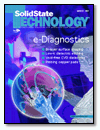Table of Contents
Solid State Technology
Year 2001
Issue 3
 | FEATURES
E Manufacturing
The sudden surge and interest in wafer fab e-Diagnostics
While complex in its IT implementation, the technology for implementing e-Diagnostics between fabs and equipment suppliers is available and the first significant links are now emerging. Early users of this capability are finding ways to address concerns over intellectual property and security, among other issues.
Lithography
Top surface imaging improves copper process resolution*
In a comparison to standard DUV lithography with bottom antireflection coatings, top surface imaging provides improved resolution in a via first, copper dual-damascene process. This technique effectively extends the range and use of binary masks.
Etching
Clean cycle prediction in etching processes via direct plasma control
lasma processes such as etching are typically controlled with machine parameters, but direct real-time monitoring of the plasma provides added insight and control. Prediction of when a chamber needs to be cleaned is an especially good application, preventing automatic cleaning steps when they are not yet needed.
Etching
Meeting ITRS Roadmap challenges with low-k dielectric etching
The integration of low-k dielectric materials has proven to be a significant challenge for semiconductor manufacturers. Progress has been made, though, in etching materials. Results with a variety of low-k materials are presented, with indications that ITRS requirements can be met for at least several years.
Metrology Test
Practical issues in the probing of copper pads
Copper metallization introduces new challenges for wafer probing. Material effects such as grain size and processing issues such as CMP dishing must be accounted for during probing. Testing techniques to do this have been developed. Accurate and fast Cu probing solutions are now available.
Contamination Control
Evaluating electronics-grade gas-line purging requirements
Appropriate pre-purging methods required to safely expose specialty gas delivery lines to atmosphere are not well defined. However, this consideration is particularly important when a process gas is toxic, flammable, or reactive with atmosphere.
Deposition
Trends in void-free pre-metal CVD dielectrics
Prevention of voids in CVD dielectrics is an increasingly difficult challenge as gap spacing decreases. A systematic review of the gap-fill capabilities of several CVD processes identifies trends and likely future directions.
Industry Insights
The evolution and logic behind Ethernet sensor and actuator connectivity
Time and again, the unrelenting progress described in Moore's Law has wreaked havoc with engineering vision. With the benefit of hindsight, we can now see that sensor bus technology in the semiconductor industry has gone in a direction few would have predicted.
|
|
DEPARTMENTS
New Products
New Products
Double-sided, single-wafer spin processor; Portable leak-detection unit; Diode-pumped solid-state laser; Memory testers; Reduced-grain-size cobalt target ...
Calendar
Calendar
A listing of industry events covering March, April, and May 2001.
New Literature
New Literature
2001-2002 vacuum catalog; Hot gas delivery/management brochure; Pressure measurement catalog ...
Services
Services
Semiconductor technology seminar; Air cleanliness technical guides; System designers resource guide ...
People
People
Acton Research Corp., Acton, MA, a subsidiary of Roper Industries, has named Eugene Yazbak president. He was previously executive VP of US operations at Petroleum Analyzer Co. LP. Robert Fancy has been appointed CTO. ...
Editorial
Power to the Fabs?
Are rolling blackouts in California an anomoly created by a crazy-quilt scheme cooked up by state lawmakers, or is it a warning to the whole country?
It's easy to chuckle about the system California legislators conjured up to cover its power needs (that's if you don't actually live, or work in a fab, there).
Letters
Letters
Let's demand healthy air!; Lost project?.
Market Watch
The killer application that may eat its siblings
More than 20 years ago, researchers found that selective doping and etching techniques could be used to fabricate 3-D structural elements on a silicon wafer. Shortly thereafter, they realized that the use of "sacrificial" layers, which enabled the undercutting of selected wafer elements, allowed these elements to "float" above the surface of the substrate.
World News
World News
Worldwide Highlights; USA; Japan; Asia Pacific; Europe ...
Tech News
Plastic LEDs deliver more light, applications about to boom
Results from work at the University of Arizona (UA) show that electrically conducting plastic (that is, the material in organic or plastic light-emitting devices, i.e., OLEDs) can convert 45% or more of electricity into light. Until now, the maximum efficiency was thought to be about 25%.
Eurofocus
Communicant Semiconductor Technologies
Communicant Semiconductor Technologies AG recently announced its launch, with Intel and Innovations for High Performance microelectronics (IHP) as strategic investors. Communicant will be a "pure play" IC foundry, serving the wireless, broadband, and high-performance markets.
Asiafocus
Thinking in 3-D: North etches copper bump connections for low-cost system-in-a-package*
The Japanese venture North Corp. says its new technology to join copper circuit layers with copper bumps makes a direct copper-to-copper connection that's both reliable and cheap, potentially making it practical to stack several chips in one package.
| |
|